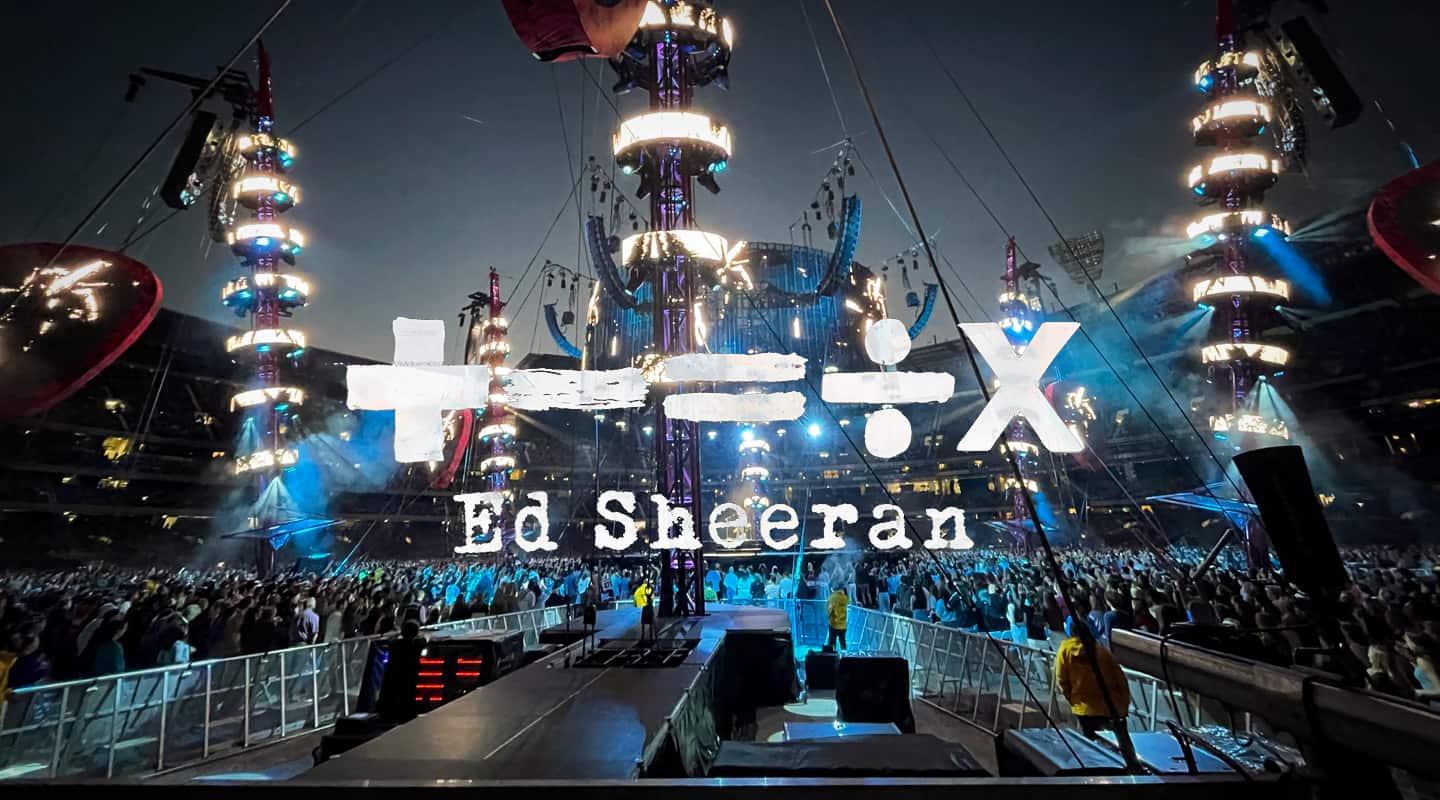
Do the Math: Ed Sheeran Live
It’s a new world record! Ed Sheeran performed to more than 215,000 people over two dates at the Melbourne Cricket Ground. Can every last punter get a great audio experience?
More than 215,000 people turned out to the two Ed Sheeran gigs at the MCG. Just let that sink in for a minute. That’s more than 6% of the adult population of the Melbourne. To state the obvious: Ed Sheeran’s appeal is truly massive — your nan, the Kumars next door, your teenage niece; heck, even ol’ Cyril down at the men’s shed hums along.
Ed’s kept his winning formula back from the days when his tours were far more modest. System engineer, Charlie Albin, has been with Ed for around eight years and has only just decided to pass the baton on to his colleague at UK rental company, Major Tom, which itself has enjoyed considerable growth as it’s tooled up to cater to the Ed Sheeran tech rider. Similarly, FOH Engineer, Chris Marsh, was there from the first showcase gigs and TV appearances.

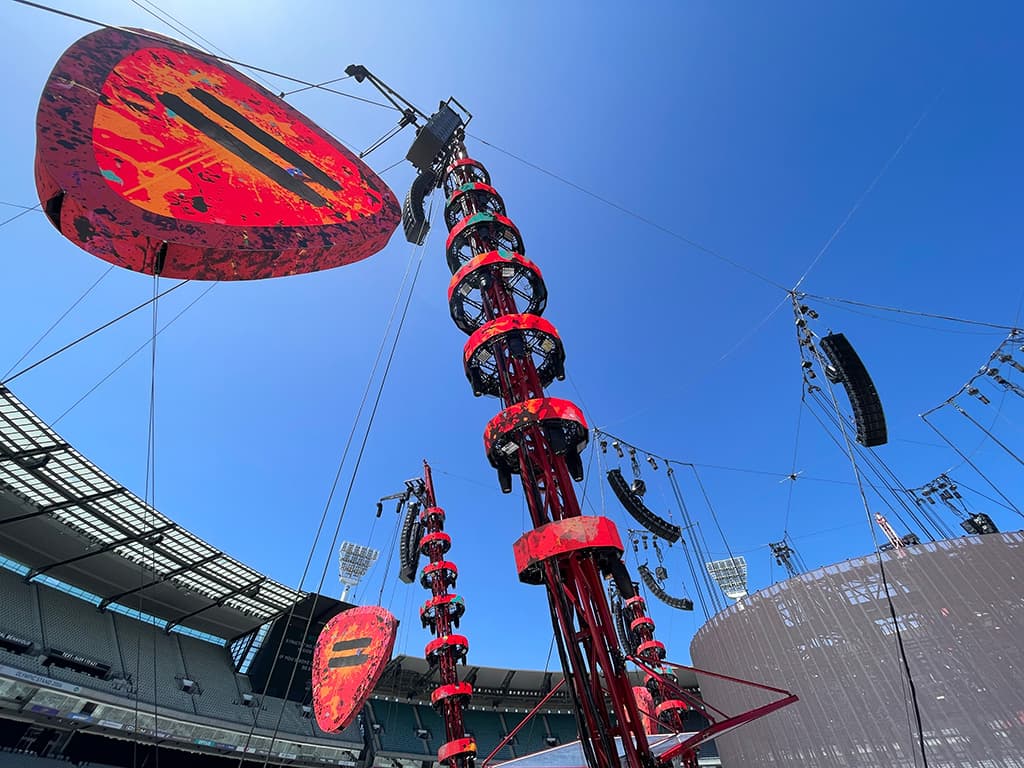
CALCULATING MATHEMATICS
This Ed Sheeran ‘Mathematics’ tour is very different to the last. The tour plays to stadiums in an in-the-round configuration. The cable-tensioned staging is an engineering marvel, carefully balanced to use the audio, lighting and video equipment as counterbalancing weights (the central LED screens weighs in at 45 tonne). If you’ve ever seen someone pulling up a model ship in a bottle then you get something of the idea — only, this ‘ship’ is life size and the ‘bottle’ is the size of the MCG!
The biggest concert tour in the world requires the biggest production spec. The headline number is 212 x Meyer Sound Panther elements… 212! There are many, many 1100-LFC subs, as you can imagine. There are 314 speaker cabinets in total, including a couple of Meyer Sound’s ULTRA-X40 monitors at front of house, which Chris Marsh relies on if it’s raining and the FOH tent is fully covered.

PRODUCTION ED ACHES
The audio challenge is obvious and immense. How do you provide audiences with a good concert experience in a venue that’s probably never experienced one? The MCG is a graveyard for audio. It’s an enormous, cavernous bowl and if you’re in-the-round, the artist is at the centre of the mayhem, being annihilated by all the reflections. The MCG spent millions on upgrading its in-house audio a few years ago, and it may be the envy of the world for the intelligibility of PA announcements, but no one’s pretending it’s a top-draw concert venue.
During soundcheck, the acoustic thwack of the snare drum said it all. The first reflection off the grandstand is fiendishly removed from the direct sound.
The MCG MAPP 3D plot clearly showing where the Panther coverage begins and ends. Leaving the top few rows to the house PA ensured Panther wasn’t slamming into the the whole of the giant LED displays.
Thankfully, some 110,000 people help to tame the acoustics but present a bunch of their own issues. System engineer, Charlie Albin, outlines the challenge and how to measure success:
“After the first song is completed and it feels like things are settled into some sort of a rhythm, I’ll go and listen to the PA at various vantage points in the venue.
“I’ll head to the top seats and listen to the PA and make an assessment on the frequency coverage. I might make some gentle tonal shifts, slight tweaks.
“Often it’s a question of: is there enough clarity in the mix? Can they hear Ed’s vocal clearly? Can they get enough musicality from the guitar for them to enjoy the experience?
“Maybe we’re not hearing quite enough intelligibility in the vocal. So do we want to pull a bit of low-mids out, which arguably could make the mix a touch less musical but we gain diction and clarity?
“Finding the right balance is everything. The show is all about Ed and people want to be able to sing along; they want to laugh at the jokes; and when he says, ‘Put your hands in the air’ Ed wants everyone involved in the show.
“As audio engineers, we’re naturally hypercritical of the sound and our work, but I think the best marker for any show, is to go sit in what I would suspect is the worst seat and see what the people around me are doing. And if they’re smiling, clapping, singing along and laughing when the artist says something on stage, then to me that’s a really good indication that we’ve delivered a great show.”
we were within 1 to 2dB difference from the front row to the back seat of the grandstand. That’s phenomenal
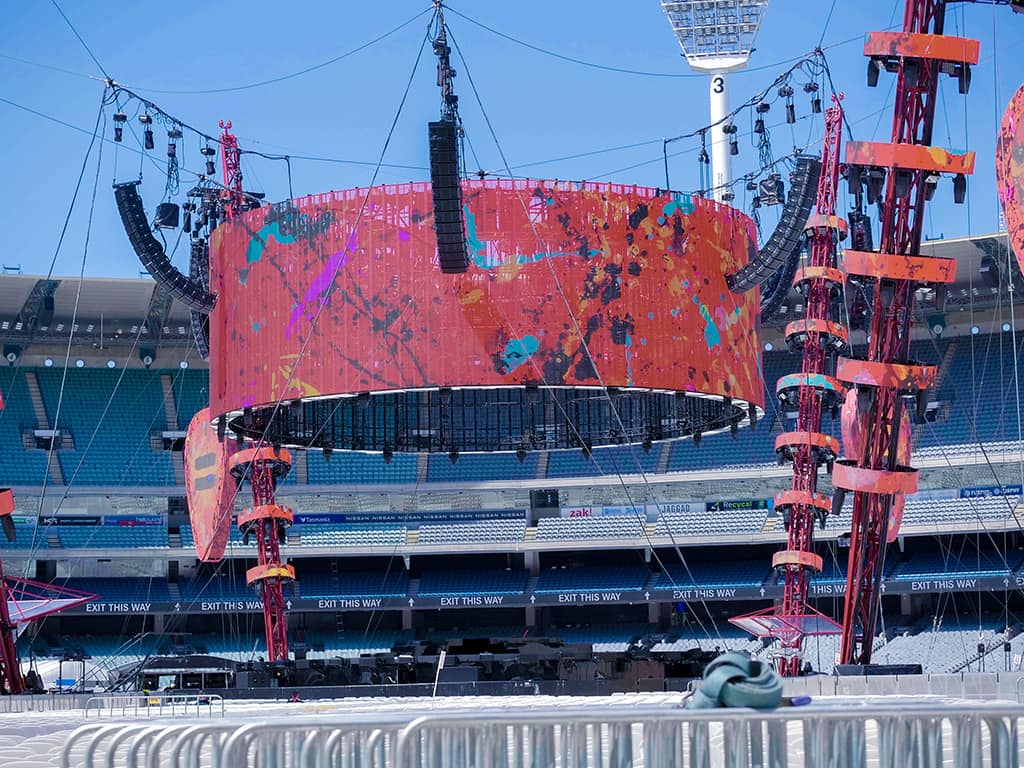
HEAR KITTY KITTY
Meyer Sound’s Panther and the Ed Sheeran tour are joined at the hip. The first 200+ boxes off the production line went straight to the tour’s first day in Dublin, mid 2022, and front of house engineer Chris Marsh consulted with John and Helen Meyer on the design: “Prior to the tour I mentioned to John and Helen that as much as I love their Leo system I would have to look at another vendor’s solution because the staging wouldn’t allow for Leo’s weight. Their answer was: ‘stick with us, we’re working on something that we think will do the trick. From that point onwards, we got heavily involved with the development of Panther. And it’s no coincidence that Panther ended up being the perfect box for this show!”
Panther’s launch promise was a heavyweight 150dB maximum output from a bantamweight 150-pound (68kg) enclosure. It’s a two-way system with many ‘ground-up’ innovations to shoehorn extreme performance into a compact enclosure.
One of the first questions Charlie Albin and Chris Marsh get is: ‘which do they prefer? Leo or Panther’? The answer is honest: they’ve never heard Panther in an arena in a ‘stereo’ configuration, while they’ve never heard Leo in a stadium, in the round.
But there’s no doubt in Charlie Albin’s mind that Panther is a step forward: “Other than Panther being a shade lower in terms of outright SPL on axis, it more or less supersedes Leo in every other way — weight, power consumption and more.
“One of the most impressive aspects of the new Panther design is the horn. The long-throw horn is the incredibly consistent — tonally there’s next to no discernible shift from on axis to off axis, until you get to the edge of the horn’s coverage and then it drops off very, very quickly.
“That aspect makes designing a system easier: just have the arrays overlap at the seam and you know you’ve got excellent coverage for every seat.
“Panther’s long throw horn is a true 80° horizontal coverage, whereas Leo’s is 75° or thereabouts. So it means we can cover more of the venue with fewer arrays and, as well as being a smaller, lighter box, we require fewer trucks, and reduced transport needs.”
Getting the Mathematics production trucked and shipped is, as you can imagine, a logistical challenge. There are now three identical stages that leap frog across the world, which get united with technical production site to site. Fun fact: staging ballast (steel plates) concealed under each of the pylons weigh around 60 tonnes per pylon.
COPPER TO CAT
The Mathematics tour sees an enormous deployment of Milan digital audio. Milan is the result of the AVnu alliance of PA manufacturers (initially) seeking to share an interoperable audio-over-IP protocol that would (among other features) guarantee arrival times to ensure phase coherent sound — something especially crucial when you’ve got long hangs of loudspeakers. The protocol uses AVB as its basis.
It means that the audio is digital from the desk (although the Digico Quantum 7 didn’t have a AVB card to natively talk Milan at the time the tour went out) via AES3 to the FOH Galaxy processor and, thereafter, Milan AVB all the way to the back of each loudspeaker via 20 x Luminex 26i Gigacore network switches in a star topology. In fact, audio from Ed’s mic (Sennheiser System 6000 via AES3) to loudspeaker is entirely digital!
“I’m not a networking guy,” confirms Charlie Albin. “But the way Milan is integrated into the Meyer Galaxy processor makes networking accessible to non-network people. The control software is really straightforward.
“Using Milan, and the way we’ve designed the system, increases our resilience as well. A show-stop fault is unthinkable for a gig like this, and Milan provides us with more options to design in network redundancy, such that if a connector goes wrong or a switch goes down we have options.
“On top of that, we have an entirely analogue backstop as well if the network fails.”
What does Charlie say to detractors who remain suspicious of using IT gear for a show?
“I think we idealise analogue. I’m a long-time analogue audio and copper cable user but all that comes with faults, indeed, show-stopping faults, as well. But we feel better about it because we are more familiar with how to fault find and how to fix an intermittent copper line.
“The advantage of a system like AVB/Milan is being able to design in network redundancy, so you can work around any issue that might come up, as it happens, and not wait until after the show.”


STRIKING UP THE BAND
Another striking difference in the Mathematics tour is the addition of a band joining Ed. That said, the bulk of the show remains firmly steered by Ed’s vocal, guitar work and his mastery of the loop pedal.
Chris Marsh: “Ed’s loop pedal setup has evolved considerably this time around. We now have five of them on stage all wirelessly controlled by Ed. I now have more loop pedal channels than ever before — I’ve now got about 16 loop pedal channels on top of his vocal.
“Ed generally carries his vocal mic because he runs around the stage, singing over his loops. But we also have a secondary microphone for him and a spare microphone and a further spare to grab and use — all the wireless is Sennheiser System 6000. The same goes for his loop pedal: there are multiple positions for his loop microphones, which he uses to loop his vocals.
“Everything’s dealt with by my trusty Digico Quantum 7. At each of the band positions, each under a structural mast, we have a Digico SD rack for the musician’s to plug into — four positions in total. The loop pedal is an Orange device picking up MADI and there’s an SD rack for all the RF under the stage and the front of house. We’ve got a Mini SD rack dealing with my local elements, including any tracks from Logic.
I had to break it to him that there was no way possible to have wedges on the rotating stage, let alone sidefills

MIXING MONITORS
Front of house engineer, Chris Marsh, is accustomed to tending to all of Ed Sheeran’s audio needs, including giving him a monitor mix. Nothing has changed in that regard on the Mathematics tour, even though a five-piece band has been added and joins Ed for some of the program.
Chris Marsh: “I continue to mix monitors for Ed and now mix monitors for the band. Sounds like a daunting task to most people, but actually, with this band and with this artist, it really isn’t — it’s just workflow management. The musicians are amazing and know the deal — get your monitor mix right during soundcheck.
“That said, early on I introduced the Klang monitoring system to allow the band an element of individual control over their own mix. We got a fair way through the rehearsal period and they got rid of that control but we retained Klang. Everything has a 360°, immersive feel with Klang, which the musicians appreciate even if they don’t know it’s happening. It helped them to be quickly involved in the mix and happy with their monitors.
“Mixing Ed’s monitors is low maintenance as well. If he ever has a problem, there’s a switch mic on stage where he can shout to me.”

IN EAR EVOLUTION
You might reasonably call Ed Sheeran the world’s most popular busker, given that’s his background, always been his MO, and how he develops a rapport with the crowd — even a stadium crowd. So it’s not a surprise that Ed didn’t immediately take to in-ear monitors, like a duck to water.
Chris Marsh: “In the 11 years I’ve been mixing Ed Sheeran, we’ve gone from using two wedges on stage to four wedges, to adding sidefills with lots of sub bass for him to feel it, to a point where we did a show one day where the audience was so loud that we couldn’t get the wedges and sidefills loud enough to hear himself. After that show he said he’d try in-ear monitors. But then for years he’d only have one earpiece in. He didn’t like feeling enclosed in his head; he liked to be with the audience.
“When we designed this show to be in the round, I had to break it to him that there was no way possible to have wedges on the rotating stage, let alone sidefills. So we were going to have to go to both ears. I introduced Klang at that point and I wanted to make him feel like he didn’t have his ears in — I wanted him to feel like he had the audience right there all the time, and Klang has enabled me to do that. Now he does keep his ears in for probably 90% of the show and is very happy with the setup.”
Interestingly, given the brutal nature of stadium acoustics, Chris has done away with crowd mics for Ed’s in-ear mix. Being in the middle of a giant colosseum every night ensures there’s plenty enough crowd coming down his Sennheiser vocal mic without dedicated crowd mics. As for the Klang system, Ed now can’t live without it.
Chris Marsh: “Again, Ed doesn’t even know about the Klang element — he doesn’t know he’s got it. But he does know when he doesn’t have it, which happened not so long ago at a small show where we were forced to return to stereo ears. At the end of the show, he pulled me aside: ‘I don’t know what was different, but I didn’t like it.’ Of course, the next show, when we were back to our own setup, it was back to normal and Ed was happy.
PANTHER PROWL
Chris Marsh talks about mixing an Ed Sheeran show in stadiums as the challenge of balancing compromises. The stadium is doing everything it can to turn your mix into indecipherable slop, and you need all your wits and all the tools at your disposal to bring order to chaos.
Chris Marsh: “Regardless of the act, mixing in a stadium in the round is about as challenging as you can get. You’ve got reflections coming from from everywhere but, equally, every stadium has its own characteristics. One stadium might be especially dreadful for sub bass — it’s just impossible to get it tight and it just wallows around all the time. At that point you have to decide whether you sacrifice some low-end impact in the show for the benefit of clarity — not my preference, there’s a balancing act there. Another stadium might be especially vicious on the vocals, with reflections impacting on intelligibility. Do you decide to mix a little bit louder to battle it out with the first reflection, or do you make the unpopular move of turning the overall level down and find a point where the clarity comes back. You just have to be willing to adapt your mix all the time to suit what you’re hearing.”
You just have to be willing to adapt your mix all the time to suit what you’re hearing
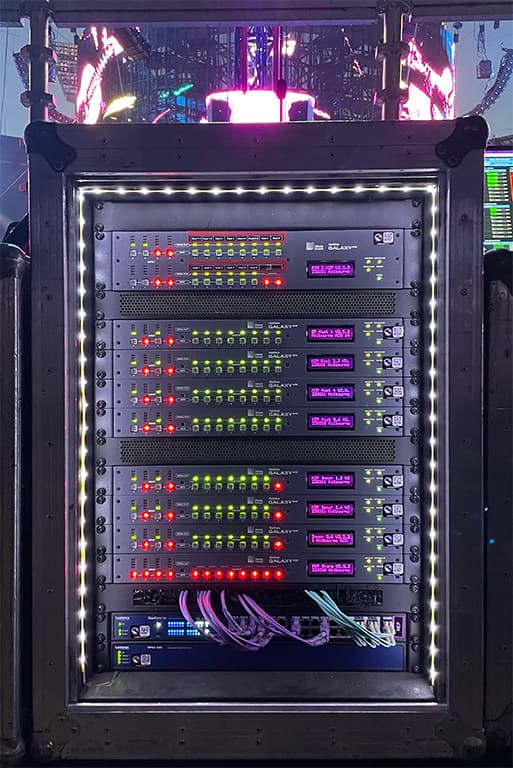
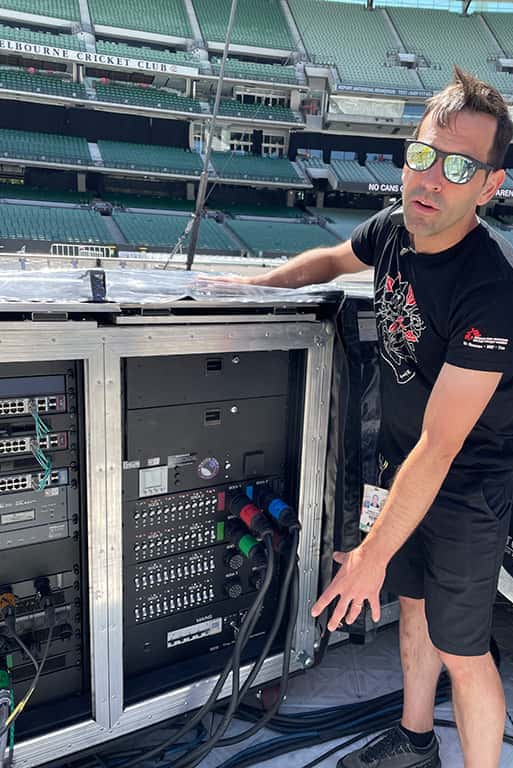
HELLO DUBLIN!
The addition of Meyer Sound’s new Panther system has been a key factor in helping Chris Marsh go into battle with the world’s stadiums. As mentioned, Meyer Sound debuted Panther on the Mathematics tour, which sounds like a marketing masterstroke. The reality was a little more ‘seat of the pants’ than that.
Chris Marsh: “I heard Panther for the first time in the stadium in Dublin on our opening date of the tour. Actually, it’s scarier than that: the first time I heard Ed’s live vocal through Panther was when he appeared on stage and said, ‘Hello, Dublin!’. So that was nerve wracking. But I do recall at the time reaching for the output fader of my nearfield X40s believing that they were still on, and they were not. Listening to Panther for the first time, everything was was right in front of me; it felt like it was near field. Mathematics is largely run in mono, but we do run in stereo to a point, and I could hear stereo imagery, which I wasn’t expecting given the front of house position, under a large hang of loudspeakers and with a mast and other staging between me and the inner ring of Panther.”
Charlie Albin picks up the story of that dramatic first night of the tour in Dublin. “We got some great feedback after the first show. Our team who’d been all around the venue, metering and comparing SPL levels, told me that we were within 1 to 2dB difference from the front row to the back seat of the grandstand. That’s phenomenal. We’ve never previously been able to achieve such a consistent coverage of that venue in that way.”













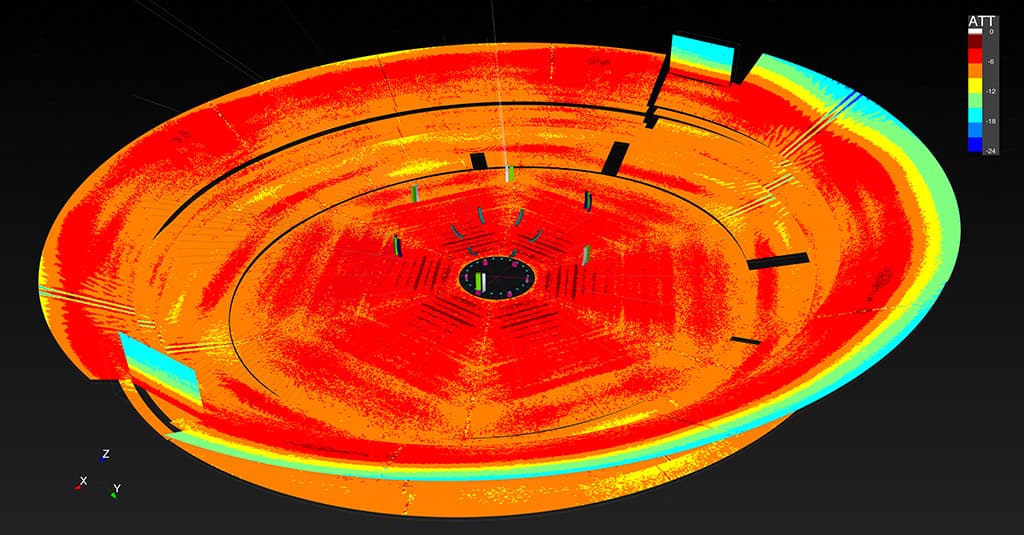






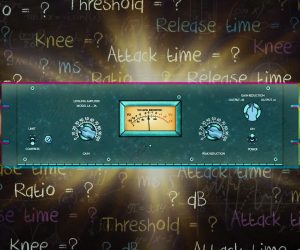




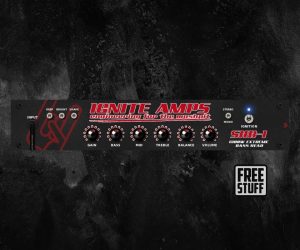


RESPONSES